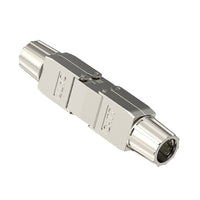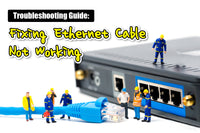A Deep Dive into Ethernet Patch Cable
Contents [show]
Many people choose a Wi-Fi connection at home to move freely around a specific place. But what if a sudden lapse in network speed affects your gaming experience? Ethernet is still commonly used in residential or commercial applications for its reliable and stable data transmission. Ethernet patch cables have generally become prevalent in our daily life, especially for a fast and stable home network.
What is an Ethernet Patch Cable?
An Ethernet patch cable, often abbreviated as a patch cable, is used to connect a network switch or router to different types of network devices, including PCs, monitors, and other IoT devices. Ethernet patch cables usually feature stranded copper wires, so they cannot be damaged when used in tight spaces.
Patch cables are short Ethernet twisted pair cables with pre-terminated 8P8C plugs (also called RJ45 plugs) on two ends, which are often applied in short-distance and point-to-point connections.
Ethernet Patch Cable vs. Bulk Ethernet Cable
You may think Ethernet patch cables and bulk Ethernet cables are the same thing, but there are slight differences between them. They serve different purposes and are used for various applications. Let’s explore the main differences between them in this blog.
Length
Patch cables are designed for short-distance network connections, and they are often seen in your home or office to connect end-user devices such as computers, switches, or routers. They are essential in LAN networks and often used in a localized place. Bulk Ethernet cables are typically sold in large spools, which can be much longer. The length of bulk Ethernet cables usually ranges from hundred to thousand feet.
Installation
Patch cables are pre-terminated with RJ45 connectors on both ends, and all you need to do is to plug the connector into the port of your device. Bulk Ethernet cables require professional installation to meet the industry’s performance and reliability.
In addition, Ethernet patch cables are usually designed for temporary network installation, and they are ideal for networking that requires quick and easy setup changes. In contrast, bulk Ethernet cables are generally used for permanent installation where cables can be run within walls and ceilings, which is an essential part of structured cabling installation in homes, buildings, or data centers.

Applications
Ethernet patch cables and bulk Ethernet cables are made for different applications. The former is used for more flexible applications. For example, you can use the patch cable to connect your computer to a router for home use. They can also be used to connect the network switch to the network switch or network switch to the patch panel in data centers or server rooms.
Bulk Ethernet cables are generally used in structured cabling, which is a permanent part of a building’s network installation. Structured cabling is composed of six systems: a work area, horizontal cabling, backbone cabling, equipment room, telecommunication room, and entrance facility. Structured cabling provides an organized solution to network infrastructure within a facility. You can often see it in office buildings, data centers, industrial facilities, remote facilities, etc.
DIY Ethernet Patch Cable
If you’re unsure about the patch cable quality on the market and love DIY projects, you can make an Ethernet patch cable yourself.
Here's the ultimate guide to crafting your custom cable – it's easier than you think!
Step 1: Before making your patch cable, you should decide what Ethernet cable you want to use in your home or office network. This tutorial will use a Cat6 cable and Cat6 pass-through RJ45 connectors.

Step 2: Cut the Ethernet cable to the length needed. If you plan to use a strain relief boot to protect the RJ45 plug, you should slide the relief boot on the cable before termination. This step is optional, and it depends on your own preference.

Step 3: Use the cable stripping to strip the cable. Some crimping tools also have the function of stripping. This step aims to expose four twisted pairs to the outside so that you can organize and arrange them. Be careful not to cut or damage eight copper wires; always pay attention not to cut yourself.

Step 4: Organize and straighten eight wires. Stop using your fingertips! You can use the cable jacket or flat-head screwdriver to straighten these copper wires.

Step 5: Cable copper wires can be arranged into different color codes and the most common standards are T568A and T568B wiring standards. The main difference between T568A and T568B is the position of orange and green pairs. Though the T568B is more widely used, you can choose either wiring diagram based on your own needs.

We will use T568B here, and the following is the color code:
- Orange/White
- Orange
- Green/White
- Blue
- Blue/White
- Green
- Brown/White
- Brown
Step 6: Cut copper wires with a sharp angle, which helps the wire easily be inserted into the RJ45 connector. Check the color code again to make sure that it is correct.

Step 7: Insert the RJ45 connector into the RJ45 crimping tool and then apply pressure on the crimping tool. The RJ45 crimping tool can cut the excess wires and make a connection. The same operation on the other end of the Ethernet cable.


Step 8: Last but not least, use the RJ45 tester to check if your patch cable can work well or not. Read the blog to learn more about how to use network tester.

Final Thoughts
Different categories of patch cords have different performances. If you want to enjoy a more fluent gaming experience, you may need CAT6, CAT6A, or higher-category patch cords. They are also available in shielded and unshielded types. Shielded patch cords are more suitable for those environments with much Electromagnetic Interference (EMI).
For more information on this topic, you can keep up on our blogs. While VCELINK offers general and basic information for our customers and other visitors to the website, it’s not professional advice.






COMMENTS